Unilever's Recruitment: Equality and Diversity Project Analysis
VerifiedAdded on 2021/02/21
|26
|4112
|35
Report
AI Summary
This report provides a comprehensive analysis of Unilever's recruitment and selection processes, focusing on the promotion of equality and diversity in the workplace. The research begins with an introduction outlining the importance of project management and its application to the chosen topic. The report then details the aims and objectives of the research, which include evaluating current trends, determining the significance of recruitment in promoting diversity, analyzing challenges, and recommending improvements. A project management plan is presented, covering costs, scope, time, quality, communication, and risk management. The report further includes a work breakdown structure with a Gantt chart, a milestone schedule, and a project schedule. The research methodology section describes the qualitative research approach, interpretivism philosophy, inductive approach, descriptive design, and data collection and analysis methods. Finally, the report includes data analysis based on thematic analysis of responses, evaluating equal treatment, and providing an overall evaluation of the project management process and applied research methodologies.
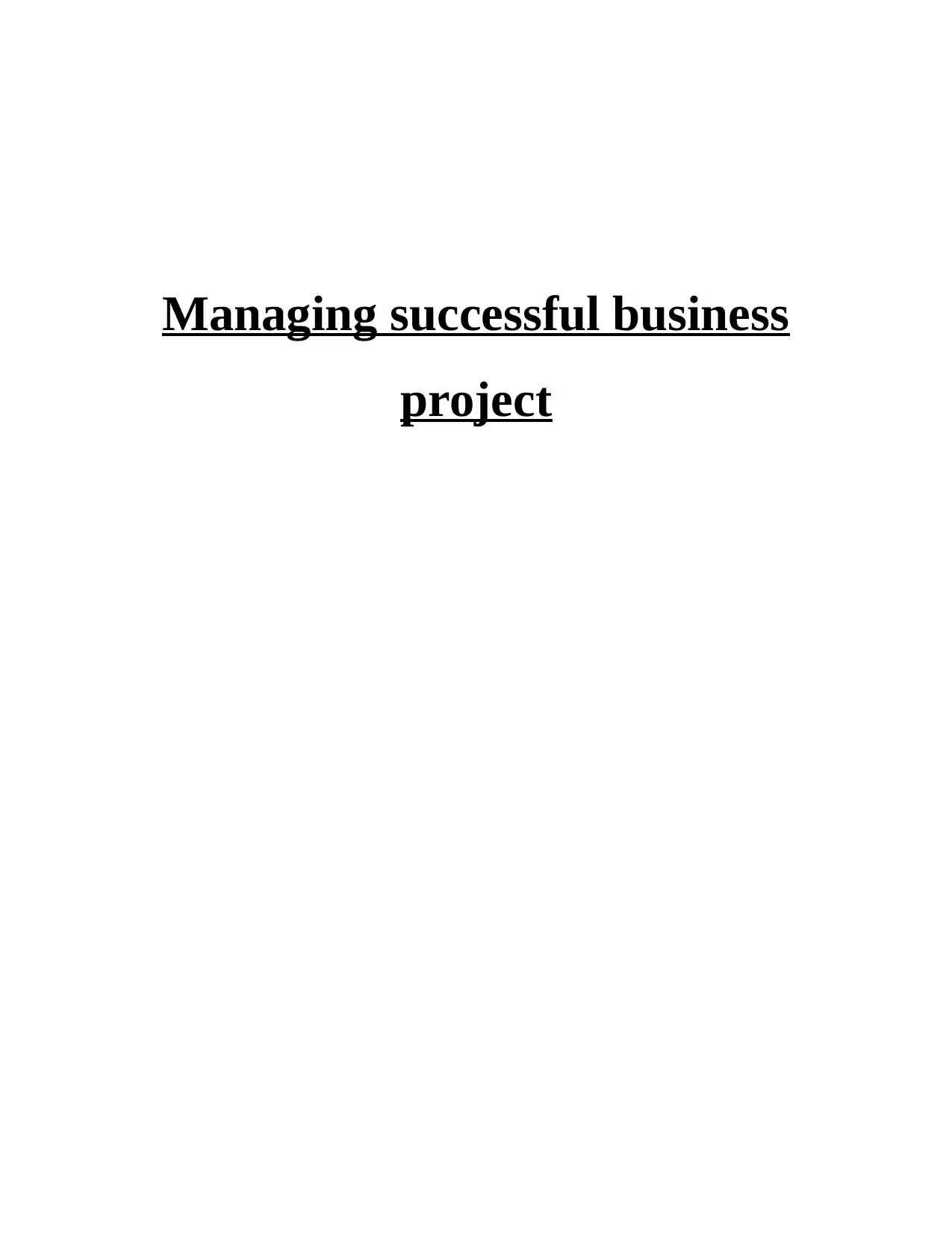
Managing successful business
project
project
Paraphrase This Document
Need a fresh take? Get an instant paraphrase of this document with our AI Paraphraser
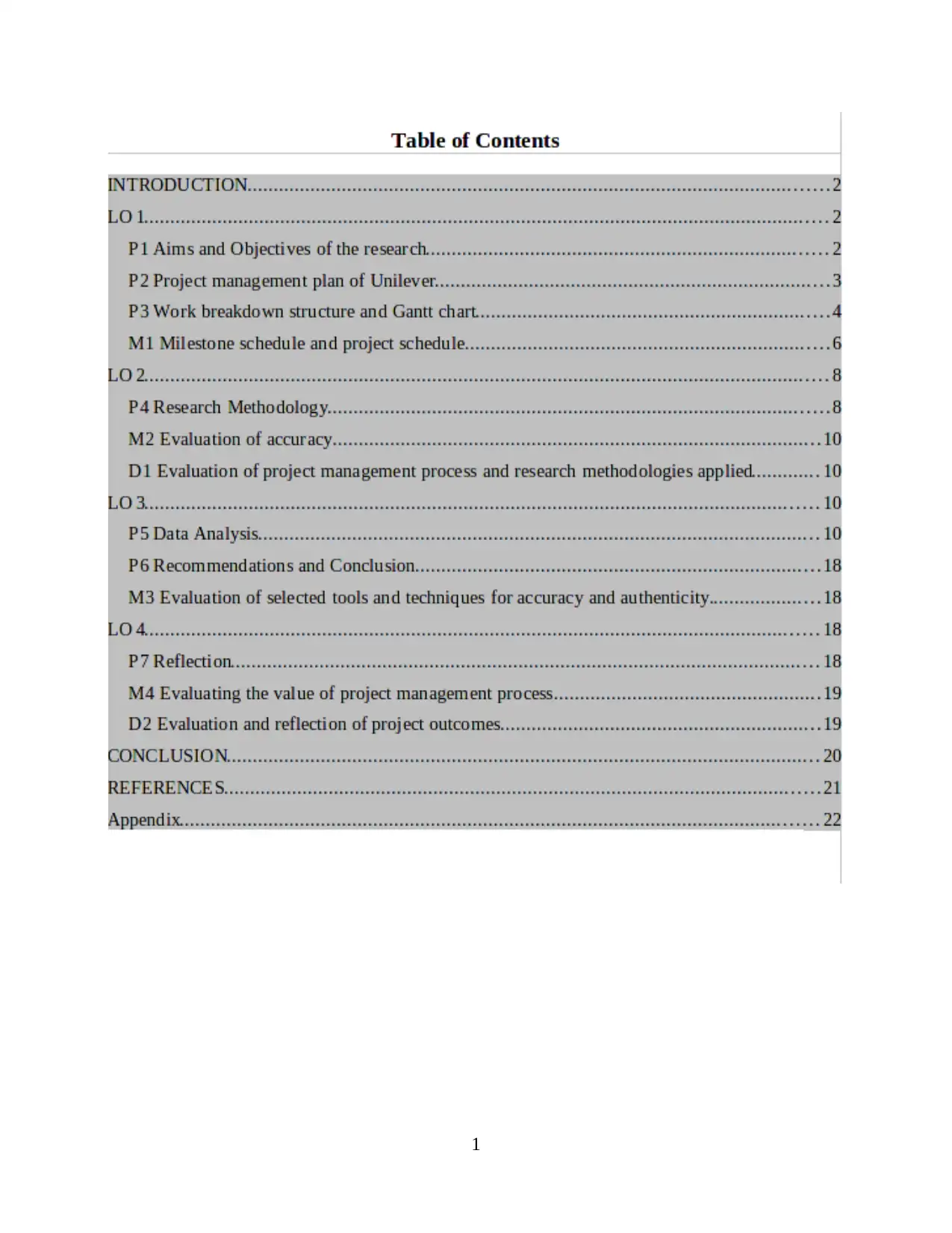
1
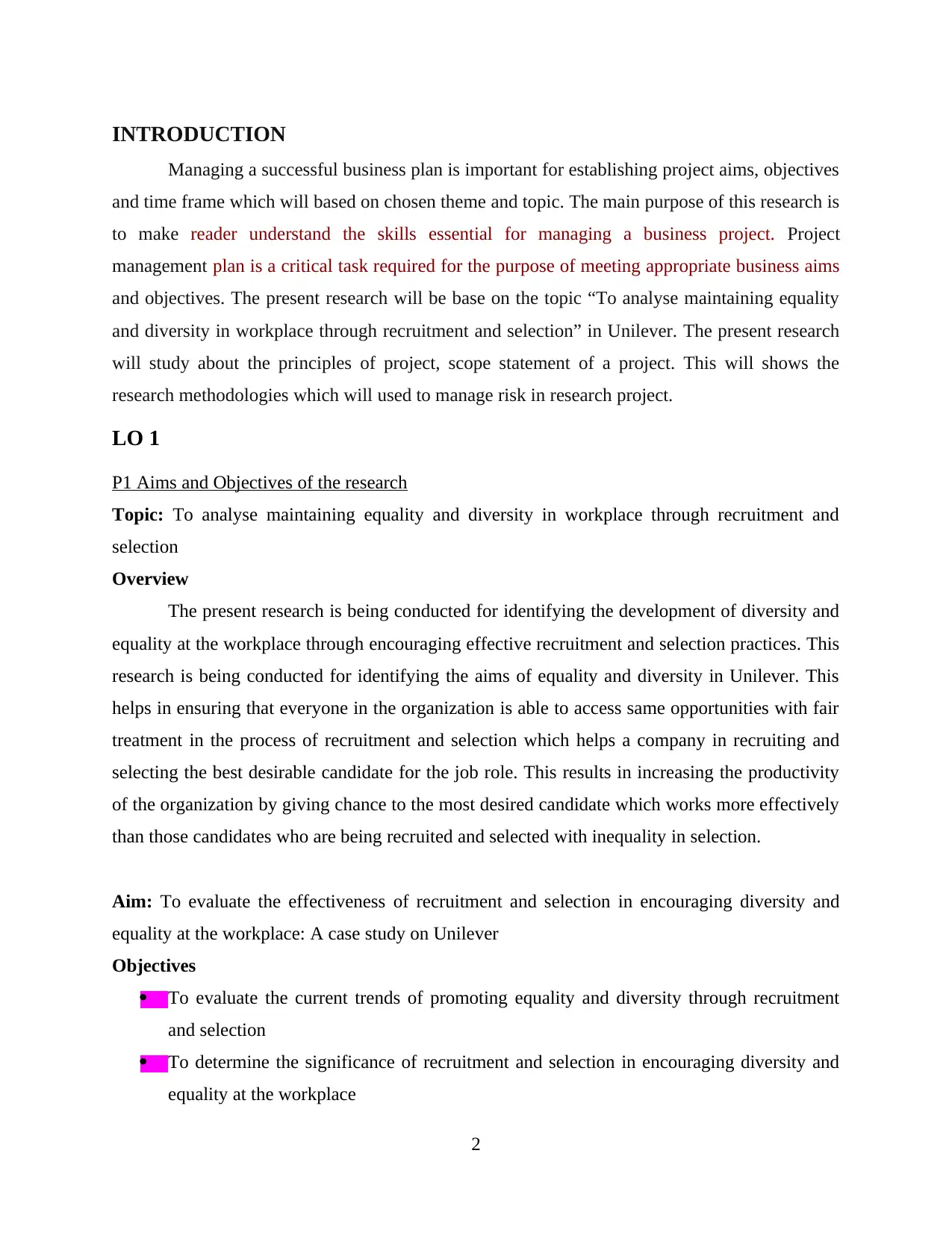
INTRODUCTION
Managing a successful business plan is important for establishing project aims, objectives
and time frame which will based on chosen theme and topic. The main purpose of this research is
to make reader understand the skills essential for managing a business project. Project
management plan is a critical task required for the purpose of meeting appropriate business aims
and objectives. The present research will be base on the topic “To analyse maintaining equality
and diversity in workplace through recruitment and selection” in Unilever. The present research
will study about the principles of project, scope statement of a project. This will shows the
research methodologies which will used to manage risk in research project.
LO 1
P1 Aims and Objectives of the research
Topic: To analyse maintaining equality and diversity in workplace through recruitment and
selection
Overview
The present research is being conducted for identifying the development of diversity and
equality at the workplace through encouraging effective recruitment and selection practices. This
research is being conducted for identifying the aims of equality and diversity in Unilever. This
helps in ensuring that everyone in the organization is able to access same opportunities with fair
treatment in the process of recruitment and selection which helps a company in recruiting and
selecting the best desirable candidate for the job role. This results in increasing the productivity
of the organization by giving chance to the most desired candidate which works more effectively
than those candidates who are being recruited and selected with inequality in selection.
Aim: To evaluate the effectiveness of recruitment and selection in encouraging diversity and
equality at the workplace: A case study on Unilever
Objectives
To evaluate the current trends of promoting equality and diversity through recruitment
and selection
To determine the significance of recruitment and selection in encouraging diversity and
equality at the workplace
2
Managing a successful business plan is important for establishing project aims, objectives
and time frame which will based on chosen theme and topic. The main purpose of this research is
to make reader understand the skills essential for managing a business project. Project
management plan is a critical task required for the purpose of meeting appropriate business aims
and objectives. The present research will be base on the topic “To analyse maintaining equality
and diversity in workplace through recruitment and selection” in Unilever. The present research
will study about the principles of project, scope statement of a project. This will shows the
research methodologies which will used to manage risk in research project.
LO 1
P1 Aims and Objectives of the research
Topic: To analyse maintaining equality and diversity in workplace through recruitment and
selection
Overview
The present research is being conducted for identifying the development of diversity and
equality at the workplace through encouraging effective recruitment and selection practices. This
research is being conducted for identifying the aims of equality and diversity in Unilever. This
helps in ensuring that everyone in the organization is able to access same opportunities with fair
treatment in the process of recruitment and selection which helps a company in recruiting and
selecting the best desirable candidate for the job role. This results in increasing the productivity
of the organization by giving chance to the most desired candidate which works more effectively
than those candidates who are being recruited and selected with inequality in selection.
Aim: To evaluate the effectiveness of recruitment and selection in encouraging diversity and
equality at the workplace: A case study on Unilever
Objectives
To evaluate the current trends of promoting equality and diversity through recruitment
and selection
To determine the significance of recruitment and selection in encouraging diversity and
equality at the workplace
2
⊘ This is a preview!⊘
Do you want full access?
Subscribe today to unlock all pages.

Trusted by 1+ million students worldwide
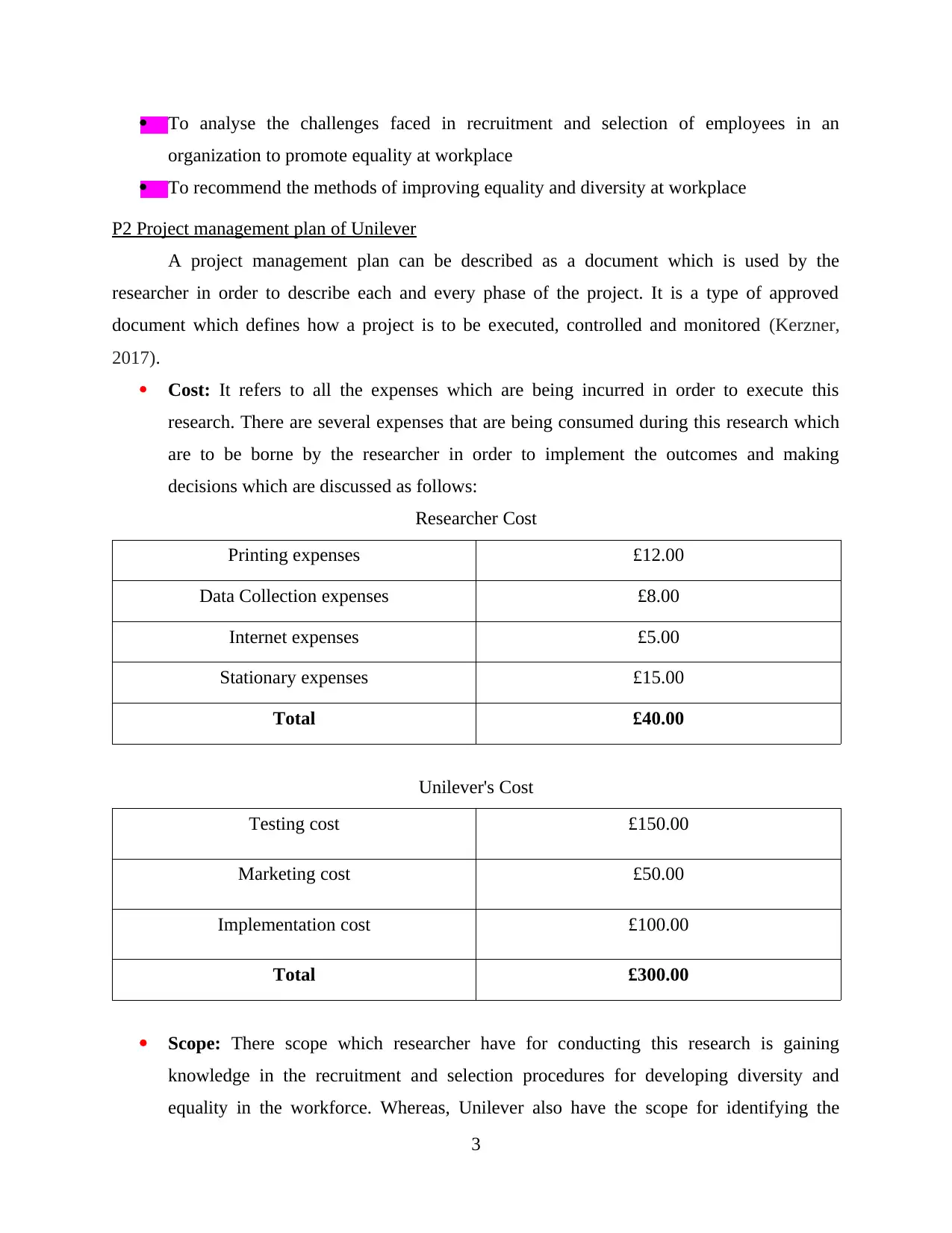
To analyse the challenges faced in recruitment and selection of employees in an
organization to promote equality at workplace
To recommend the methods of improving equality and diversity at workplace
P2 Project management plan of Unilever
A project management plan can be described as a document which is used by the
researcher in order to describe each and every phase of the project. It is a type of approved
document which defines how a project is to be executed, controlled and monitored (Kerzner,
2017).
Cost: It refers to all the expenses which are being incurred in order to execute this
research. There are several expenses that are being consumed during this research which
are to be borne by the researcher in order to implement the outcomes and making
decisions which are discussed as follows:
Researcher Cost
Printing expenses £12.00
Data Collection expenses £8.00
Internet expenses £5.00
Stationary expenses £15.00
Total £40.00
Unilever's Cost
Testing cost £150.00
Marketing cost £50.00
Implementation cost £100.00
Total £300.00
Scope: There scope which researcher have for conducting this research is gaining
knowledge in the recruitment and selection procedures for developing diversity and
equality in the workforce. Whereas, Unilever also have the scope for identifying the
3
organization to promote equality at workplace
To recommend the methods of improving equality and diversity at workplace
P2 Project management plan of Unilever
A project management plan can be described as a document which is used by the
researcher in order to describe each and every phase of the project. It is a type of approved
document which defines how a project is to be executed, controlled and monitored (Kerzner,
2017).
Cost: It refers to all the expenses which are being incurred in order to execute this
research. There are several expenses that are being consumed during this research which
are to be borne by the researcher in order to implement the outcomes and making
decisions which are discussed as follows:
Researcher Cost
Printing expenses £12.00
Data Collection expenses £8.00
Internet expenses £5.00
Stationary expenses £15.00
Total £40.00
Unilever's Cost
Testing cost £150.00
Marketing cost £50.00
Implementation cost £100.00
Total £300.00
Scope: There scope which researcher have for conducting this research is gaining
knowledge in the recruitment and selection procedures for developing diversity and
equality in the workforce. Whereas, Unilever also have the scope for identifying the
3
Paraphrase This Document
Need a fresh take? Get an instant paraphrase of this document with our AI Paraphraser
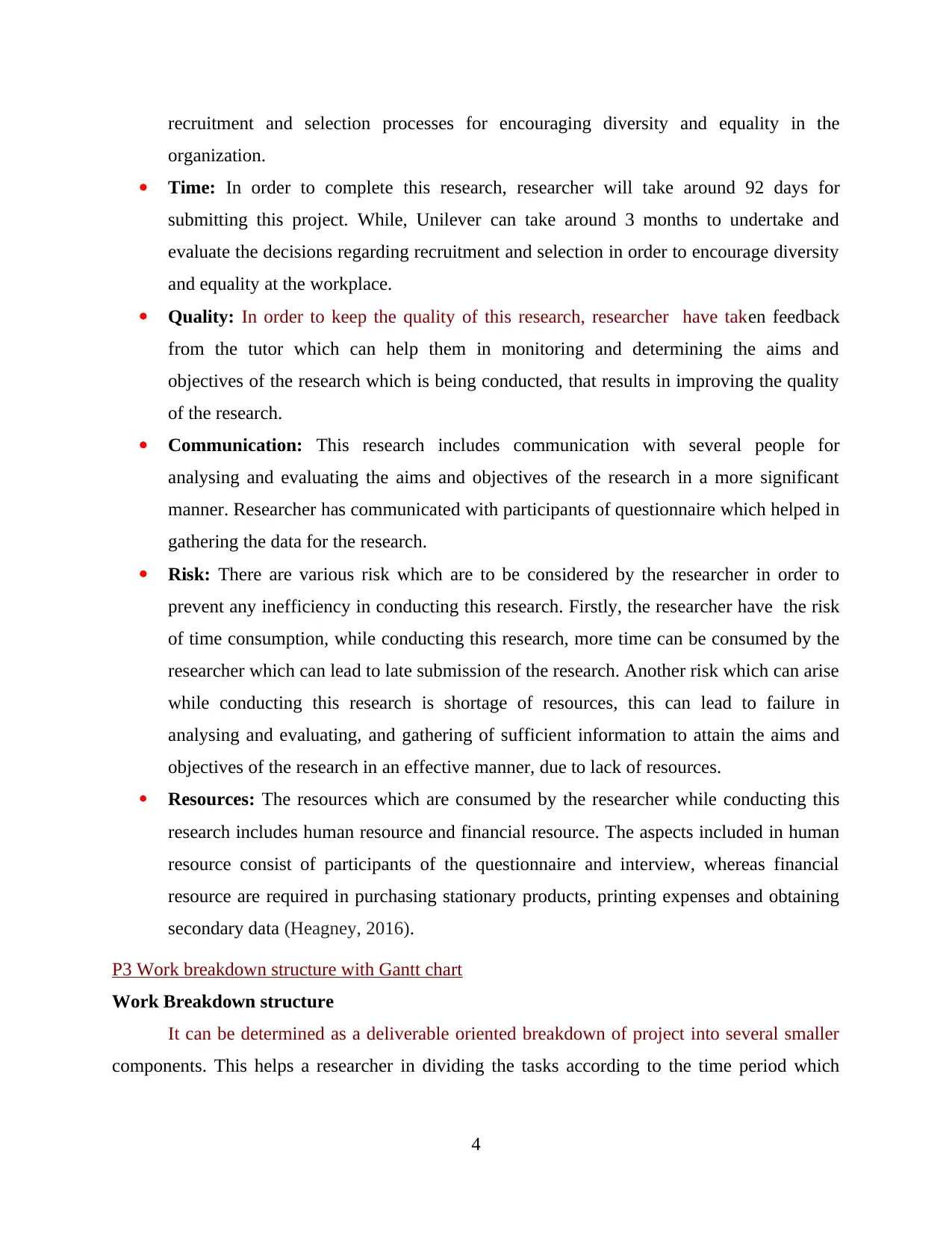
recruitment and selection processes for encouraging diversity and equality in the
organization.
Time: In order to complete this research, researcher will take around 92 days for
submitting this project. While, Unilever can take around 3 months to undertake and
evaluate the decisions regarding recruitment and selection in order to encourage diversity
and equality at the workplace.
Quality: In order to keep the quality of this research, researcher have taken feedback
from the tutor which can help them in monitoring and determining the aims and
objectives of the research which is being conducted, that results in improving the quality
of the research.
Communication: This research includes communication with several people for
analysing and evaluating the aims and objectives of the research in a more significant
manner. Researcher has communicated with participants of questionnaire which helped in
gathering the data for the research.
Risk: There are various risk which are to be considered by the researcher in order to
prevent any inefficiency in conducting this research. Firstly, the researcher have the risk
of time consumption, while conducting this research, more time can be consumed by the
researcher which can lead to late submission of the research. Another risk which can arise
while conducting this research is shortage of resources, this can lead to failure in
analysing and evaluating, and gathering of sufficient information to attain the aims and
objectives of the research in an effective manner, due to lack of resources.
Resources: The resources which are consumed by the researcher while conducting this
research includes human resource and financial resource. The aspects included in human
resource consist of participants of the questionnaire and interview, whereas financial
resource are required in purchasing stationary products, printing expenses and obtaining
secondary data (Heagney, 2016).
P3 Work breakdown structure with Gantt chart
Work Breakdown structure
It can be determined as a deliverable oriented breakdown of project into several smaller
components. This helps a researcher in dividing the tasks according to the time period which
4
organization.
Time: In order to complete this research, researcher will take around 92 days for
submitting this project. While, Unilever can take around 3 months to undertake and
evaluate the decisions regarding recruitment and selection in order to encourage diversity
and equality at the workplace.
Quality: In order to keep the quality of this research, researcher have taken feedback
from the tutor which can help them in monitoring and determining the aims and
objectives of the research which is being conducted, that results in improving the quality
of the research.
Communication: This research includes communication with several people for
analysing and evaluating the aims and objectives of the research in a more significant
manner. Researcher has communicated with participants of questionnaire which helped in
gathering the data for the research.
Risk: There are various risk which are to be considered by the researcher in order to
prevent any inefficiency in conducting this research. Firstly, the researcher have the risk
of time consumption, while conducting this research, more time can be consumed by the
researcher which can lead to late submission of the research. Another risk which can arise
while conducting this research is shortage of resources, this can lead to failure in
analysing and evaluating, and gathering of sufficient information to attain the aims and
objectives of the research in an effective manner, due to lack of resources.
Resources: The resources which are consumed by the researcher while conducting this
research includes human resource and financial resource. The aspects included in human
resource consist of participants of the questionnaire and interview, whereas financial
resource are required in purchasing stationary products, printing expenses and obtaining
secondary data (Heagney, 2016).
P3 Work breakdown structure with Gantt chart
Work Breakdown structure
It can be determined as a deliverable oriented breakdown of project into several smaller
components. This helps a researcher in dividing the tasks according to the time period which
4
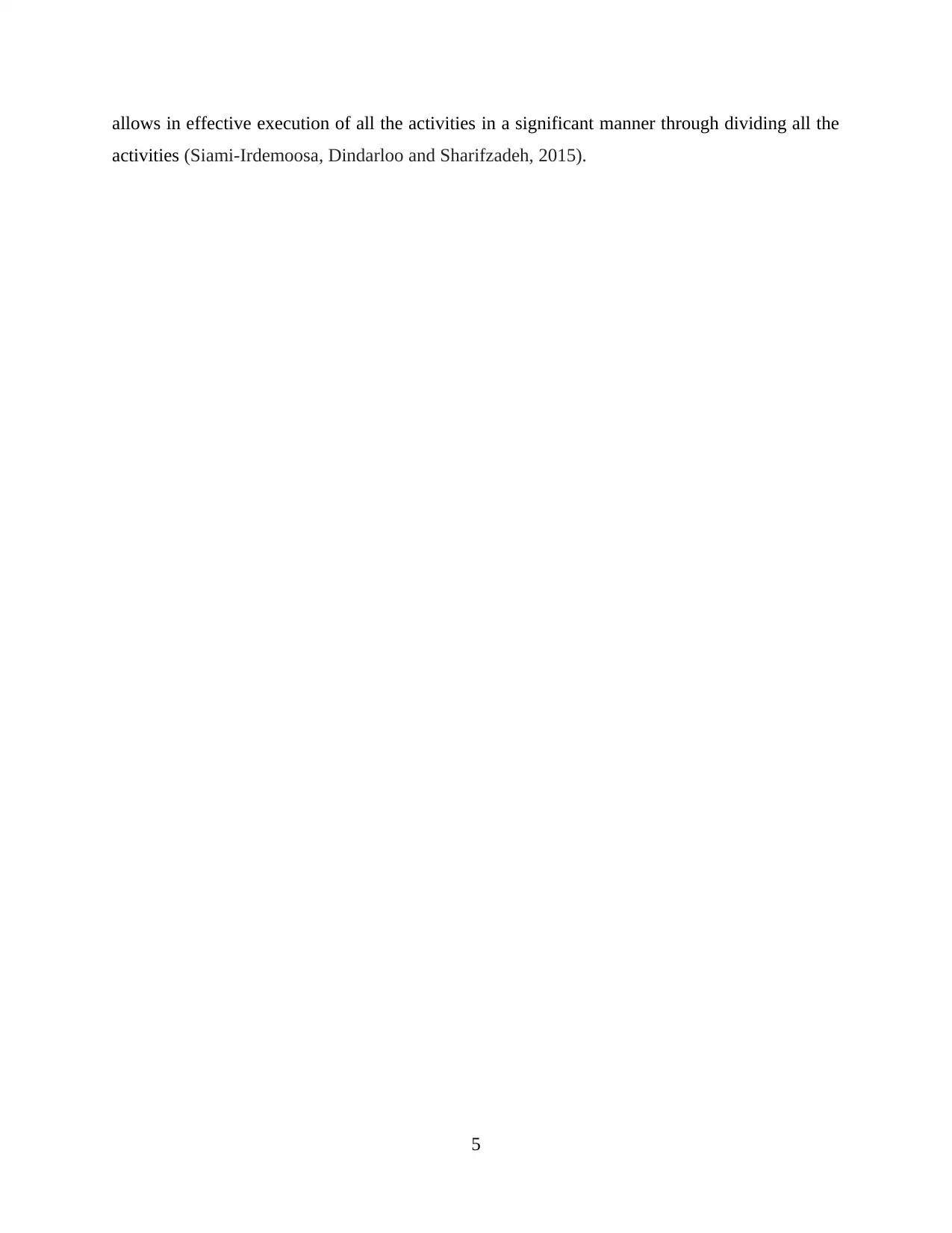
allows in effective execution of all the activities in a significant manner through dividing all the
activities (Siami-Irdemoosa, Dindarloo and Sharifzadeh, 2015).
5
activities (Siami-Irdemoosa, Dindarloo and Sharifzadeh, 2015).
5
⊘ This is a preview!⊘
Do you want full access?
Subscribe today to unlock all pages.

Trusted by 1+ million students worldwide
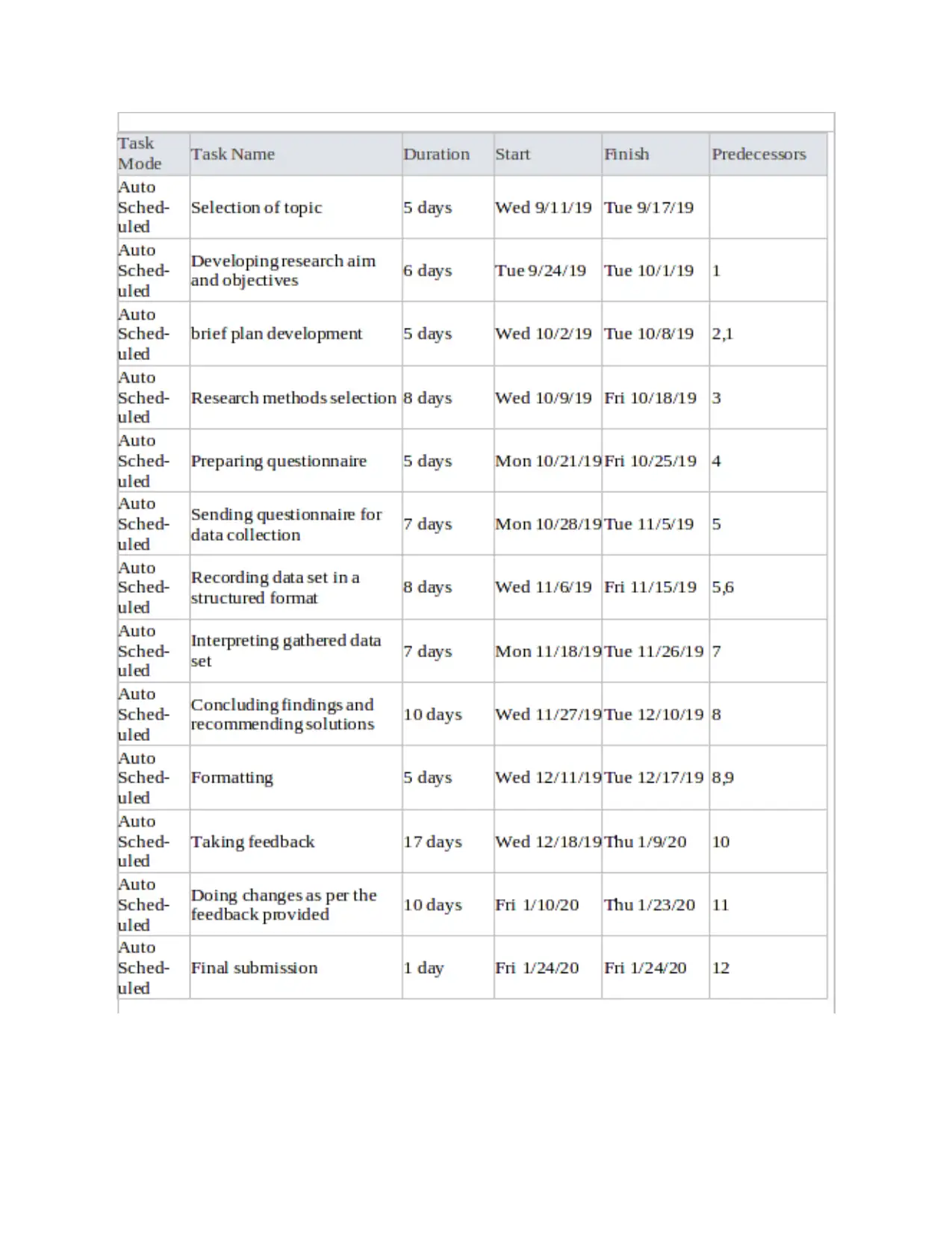
Paraphrase This Document
Need a fresh take? Get an instant paraphrase of this document with our AI Paraphraser

7
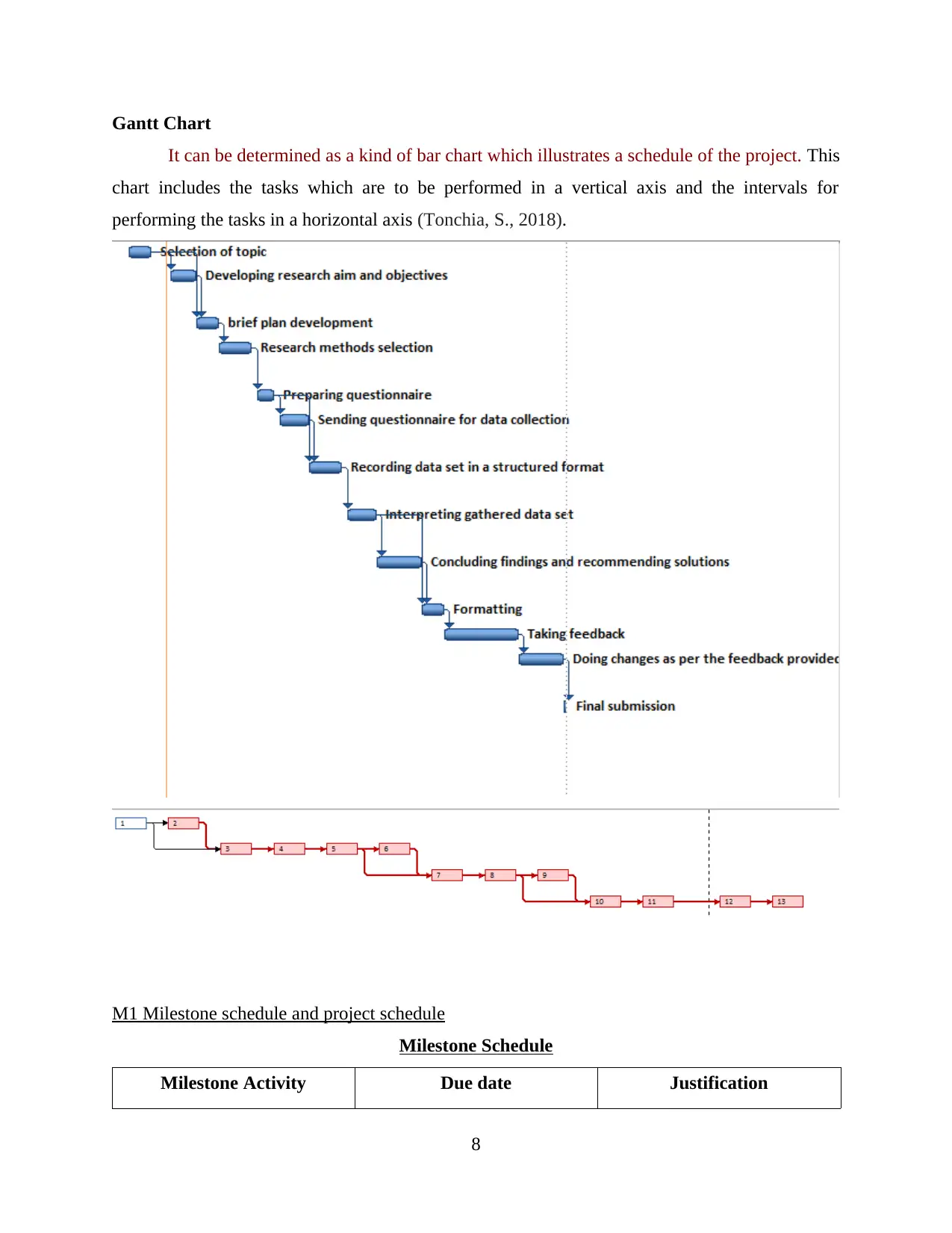
Gantt Chart
It can be determined as a kind of bar chart which illustrates a schedule of the project. This
chart includes the tasks which are to be performed in a vertical axis and the intervals for
performing the tasks in a horizontal axis (Tonchia, S., 2018).
M1 Milestone schedule and project schedule
Milestone Schedule
Milestone Activity Due date Justification
8
It can be determined as a kind of bar chart which illustrates a schedule of the project. This
chart includes the tasks which are to be performed in a vertical axis and the intervals for
performing the tasks in a horizontal axis (Tonchia, S., 2018).
M1 Milestone schedule and project schedule
Milestone Schedule
Milestone Activity Due date Justification
8
⊘ This is a preview!⊘
Do you want full access?
Subscribe today to unlock all pages.

Trusted by 1+ million students worldwide
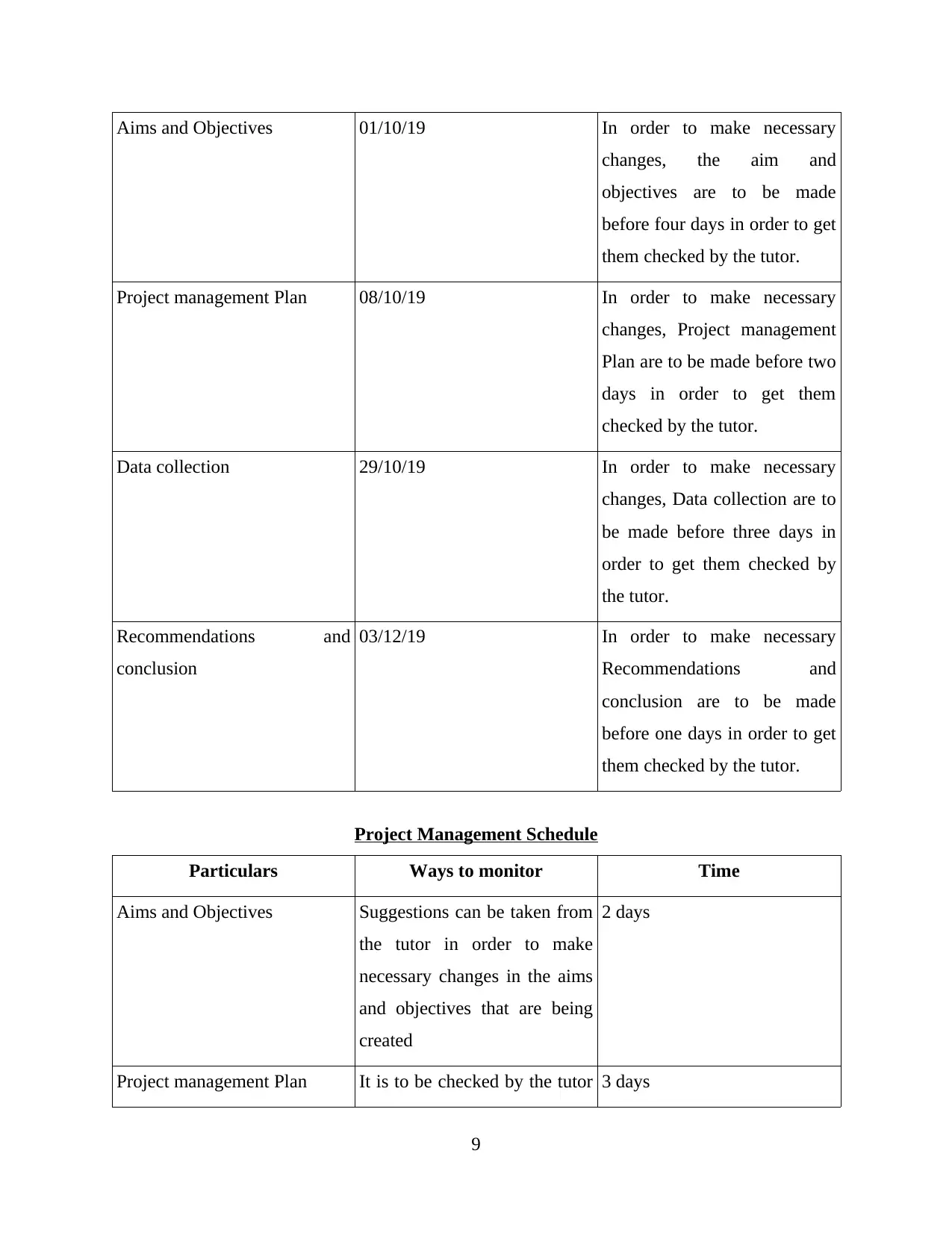
Aims and Objectives 01/10/19 In order to make necessary
changes, the aim and
objectives are to be made
before four days in order to get
them checked by the tutor.
Project management Plan 08/10/19 In order to make necessary
changes, Project management
Plan are to be made before two
days in order to get them
checked by the tutor.
Data collection 29/10/19 In order to make necessary
changes, Data collection are to
be made before three days in
order to get them checked by
the tutor.
Recommendations and
conclusion
03/12/19 In order to make necessary
Recommendations and
conclusion are to be made
before one days in order to get
them checked by the tutor.
Project Management Schedule
Particulars Ways to monitor Time
Aims and Objectives Suggestions can be taken from
the tutor in order to make
necessary changes in the aims
and objectives that are being
created
2 days
Project management Plan It is to be checked by the tutor 3 days
9
changes, the aim and
objectives are to be made
before four days in order to get
them checked by the tutor.
Project management Plan 08/10/19 In order to make necessary
changes, Project management
Plan are to be made before two
days in order to get them
checked by the tutor.
Data collection 29/10/19 In order to make necessary
changes, Data collection are to
be made before three days in
order to get them checked by
the tutor.
Recommendations and
conclusion
03/12/19 In order to make necessary
Recommendations and
conclusion are to be made
before one days in order to get
them checked by the tutor.
Project Management Schedule
Particulars Ways to monitor Time
Aims and Objectives Suggestions can be taken from
the tutor in order to make
necessary changes in the aims
and objectives that are being
created
2 days
Project management Plan It is to be checked by the tutor 3 days
9
Paraphrase This Document
Need a fresh take? Get an instant paraphrase of this document with our AI Paraphraser
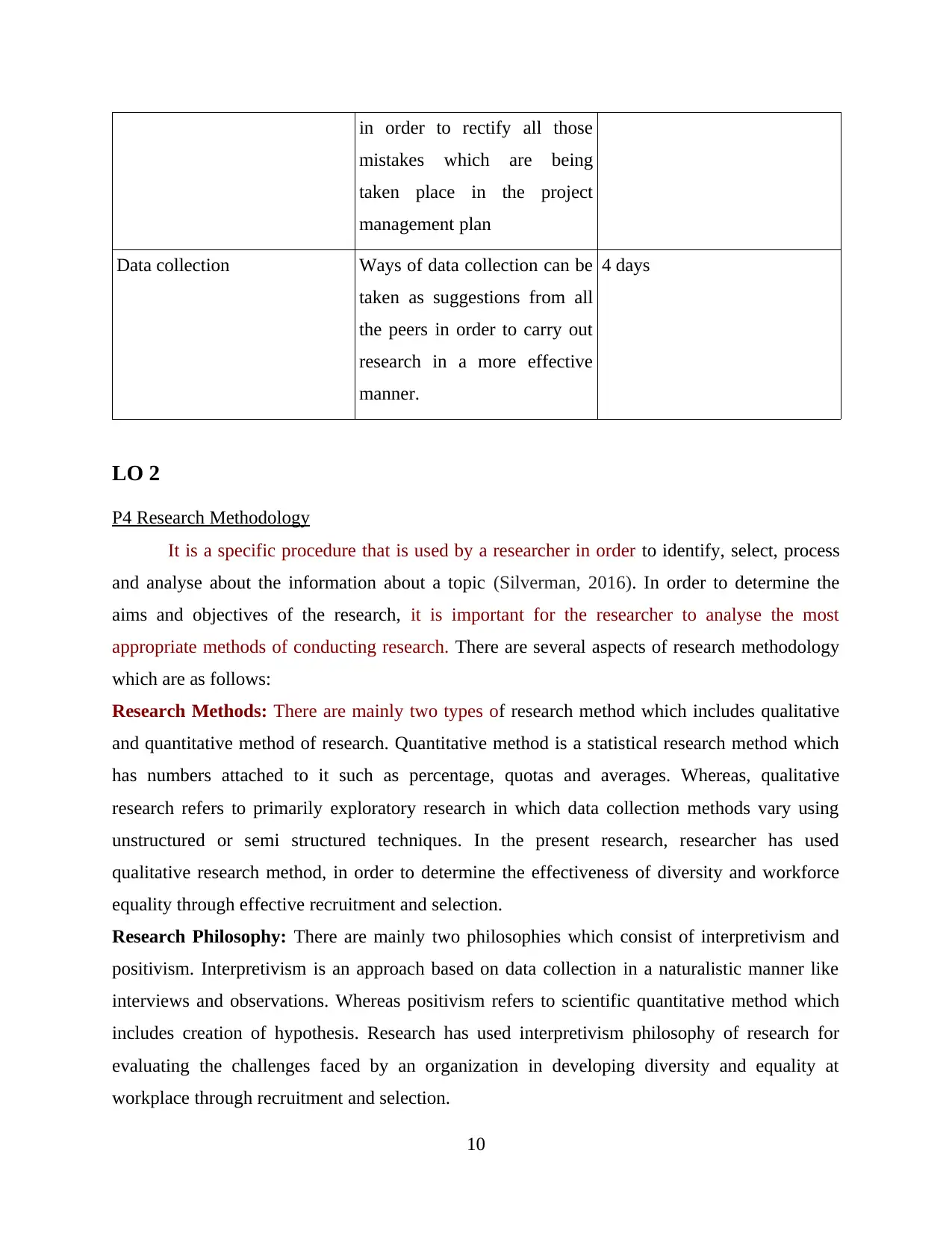
in order to rectify all those
mistakes which are being
taken place in the project
management plan
Data collection Ways of data collection can be
taken as suggestions from all
the peers in order to carry out
research in a more effective
manner.
4 days
LO 2
P4 Research Methodology
It is a specific procedure that is used by a researcher in order to identify, select, process
and analyse about the information about a topic (Silverman, 2016). In order to determine the
aims and objectives of the research, it is important for the researcher to analyse the most
appropriate methods of conducting research. There are several aspects of research methodology
which are as follows:
Research Methods: There are mainly two types of research method which includes qualitative
and quantitative method of research. Quantitative method is a statistical research method which
has numbers attached to it such as percentage, quotas and averages. Whereas, qualitative
research refers to primarily exploratory research in which data collection methods vary using
unstructured or semi structured techniques. In the present research, researcher has used
qualitative research method, in order to determine the effectiveness of diversity and workforce
equality through effective recruitment and selection.
Research Philosophy: There are mainly two philosophies which consist of interpretivism and
positivism. Interpretivism is an approach based on data collection in a naturalistic manner like
interviews and observations. Whereas positivism refers to scientific quantitative method which
includes creation of hypothesis. Research has used interpretivism philosophy of research for
evaluating the challenges faced by an organization in developing diversity and equality at
workplace through recruitment and selection.
10
mistakes which are being
taken place in the project
management plan
Data collection Ways of data collection can be
taken as suggestions from all
the peers in order to carry out
research in a more effective
manner.
4 days
LO 2
P4 Research Methodology
It is a specific procedure that is used by a researcher in order to identify, select, process
and analyse about the information about a topic (Silverman, 2016). In order to determine the
aims and objectives of the research, it is important for the researcher to analyse the most
appropriate methods of conducting research. There are several aspects of research methodology
which are as follows:
Research Methods: There are mainly two types of research method which includes qualitative
and quantitative method of research. Quantitative method is a statistical research method which
has numbers attached to it such as percentage, quotas and averages. Whereas, qualitative
research refers to primarily exploratory research in which data collection methods vary using
unstructured or semi structured techniques. In the present research, researcher has used
qualitative research method, in order to determine the effectiveness of diversity and workforce
equality through effective recruitment and selection.
Research Philosophy: There are mainly two philosophies which consist of interpretivism and
positivism. Interpretivism is an approach based on data collection in a naturalistic manner like
interviews and observations. Whereas positivism refers to scientific quantitative method which
includes creation of hypothesis. Research has used interpretivism philosophy of research for
evaluating the challenges faced by an organization in developing diversity and equality at
workplace through recruitment and selection.
10
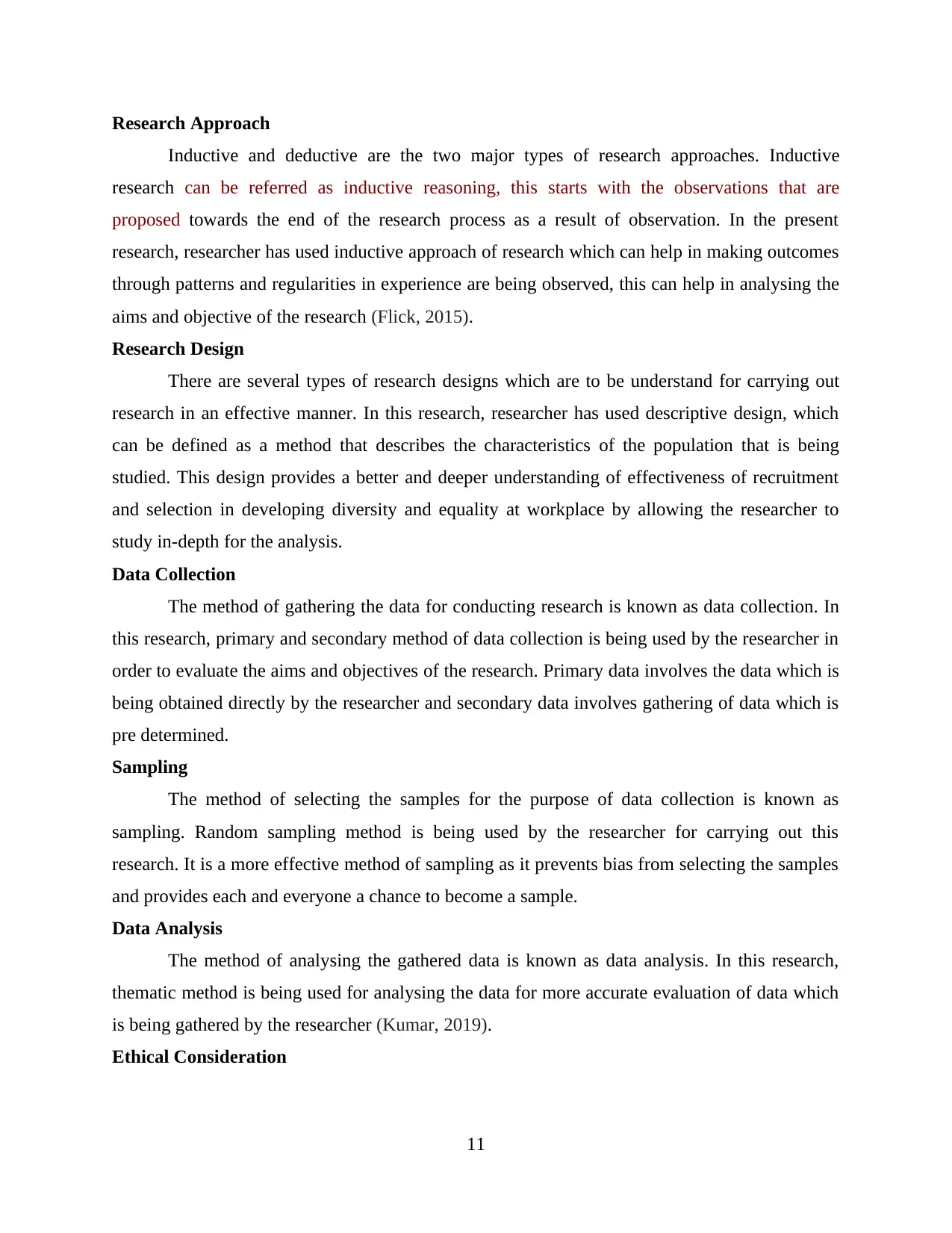
Research Approach
Inductive and deductive are the two major types of research approaches. Inductive
research can be referred as inductive reasoning, this starts with the observations that are
proposed towards the end of the research process as a result of observation. In the present
research, researcher has used inductive approach of research which can help in making outcomes
through patterns and regularities in experience are being observed, this can help in analysing the
aims and objective of the research (Flick, 2015).
Research Design
There are several types of research designs which are to be understand for carrying out
research in an effective manner. In this research, researcher has used descriptive design, which
can be defined as a method that describes the characteristics of the population that is being
studied. This design provides a better and deeper understanding of effectiveness of recruitment
and selection in developing diversity and equality at workplace by allowing the researcher to
study in-depth for the analysis.
Data Collection
The method of gathering the data for conducting research is known as data collection. In
this research, primary and secondary method of data collection is being used by the researcher in
order to evaluate the aims and objectives of the research. Primary data involves the data which is
being obtained directly by the researcher and secondary data involves gathering of data which is
pre determined.
Sampling
The method of selecting the samples for the purpose of data collection is known as
sampling. Random sampling method is being used by the researcher for carrying out this
research. It is a more effective method of sampling as it prevents bias from selecting the samples
and provides each and everyone a chance to become a sample.
Data Analysis
The method of analysing the gathered data is known as data analysis. In this research,
thematic method is being used for analysing the data for more accurate evaluation of data which
is being gathered by the researcher (Kumar, 2019).
Ethical Consideration
11
Inductive and deductive are the two major types of research approaches. Inductive
research can be referred as inductive reasoning, this starts with the observations that are
proposed towards the end of the research process as a result of observation. In the present
research, researcher has used inductive approach of research which can help in making outcomes
through patterns and regularities in experience are being observed, this can help in analysing the
aims and objective of the research (Flick, 2015).
Research Design
There are several types of research designs which are to be understand for carrying out
research in an effective manner. In this research, researcher has used descriptive design, which
can be defined as a method that describes the characteristics of the population that is being
studied. This design provides a better and deeper understanding of effectiveness of recruitment
and selection in developing diversity and equality at workplace by allowing the researcher to
study in-depth for the analysis.
Data Collection
The method of gathering the data for conducting research is known as data collection. In
this research, primary and secondary method of data collection is being used by the researcher in
order to evaluate the aims and objectives of the research. Primary data involves the data which is
being obtained directly by the researcher and secondary data involves gathering of data which is
pre determined.
Sampling
The method of selecting the samples for the purpose of data collection is known as
sampling. Random sampling method is being used by the researcher for carrying out this
research. It is a more effective method of sampling as it prevents bias from selecting the samples
and provides each and everyone a chance to become a sample.
Data Analysis
The method of analysing the gathered data is known as data analysis. In this research,
thematic method is being used for analysing the data for more accurate evaluation of data which
is being gathered by the researcher (Kumar, 2019).
Ethical Consideration
11
⊘ This is a preview!⊘
Do you want full access?
Subscribe today to unlock all pages.

Trusted by 1+ million students worldwide
1 out of 26
Related Documents
Your All-in-One AI-Powered Toolkit for Academic Success.
+13062052269
info@desklib.com
Available 24*7 on WhatsApp / Email
![[object Object]](/_next/static/media/star-bottom.7253800d.svg)
Unlock your academic potential
Copyright © 2020–2025 A2Z Services. All Rights Reserved. Developed and managed by ZUCOL.





